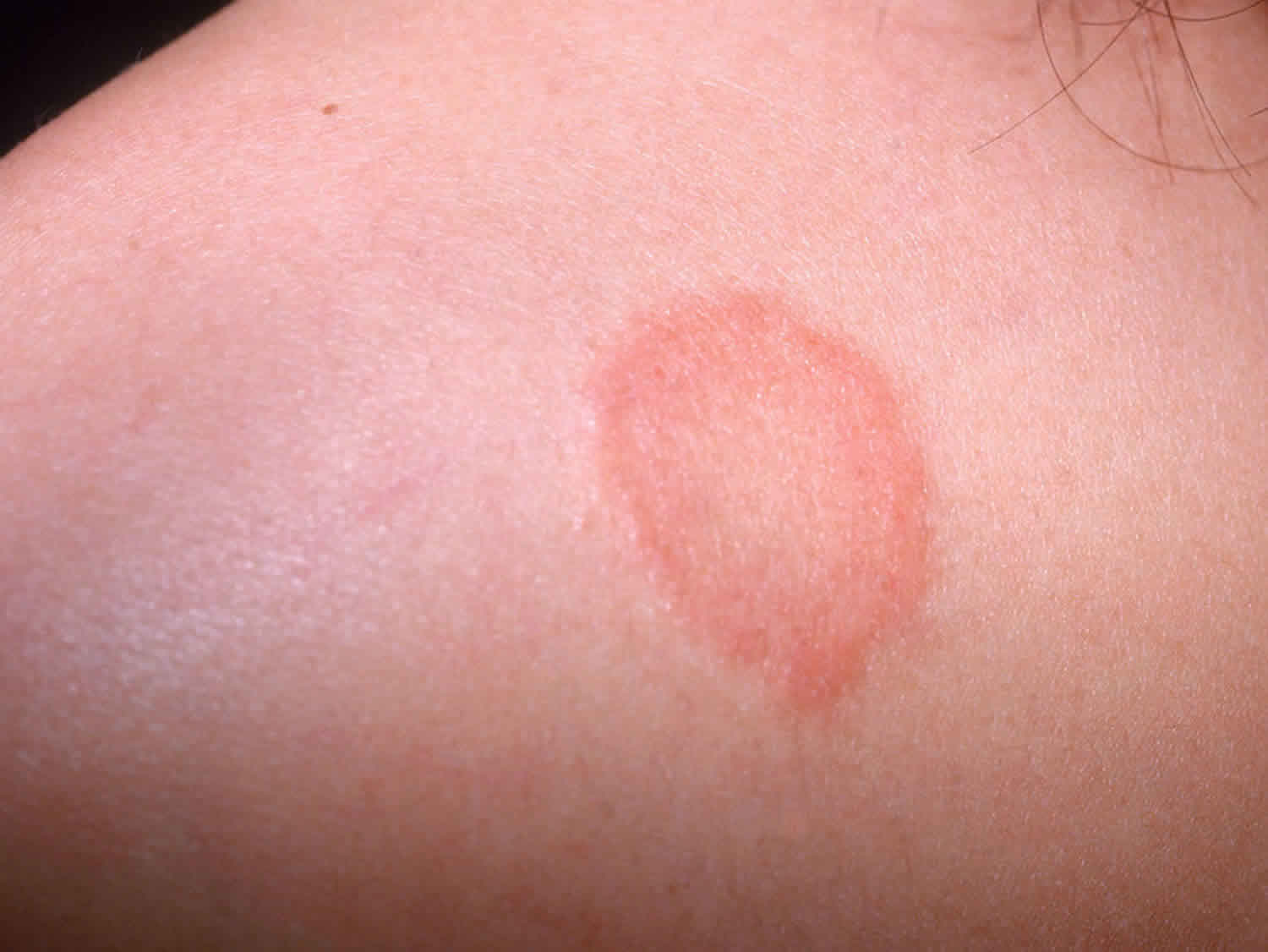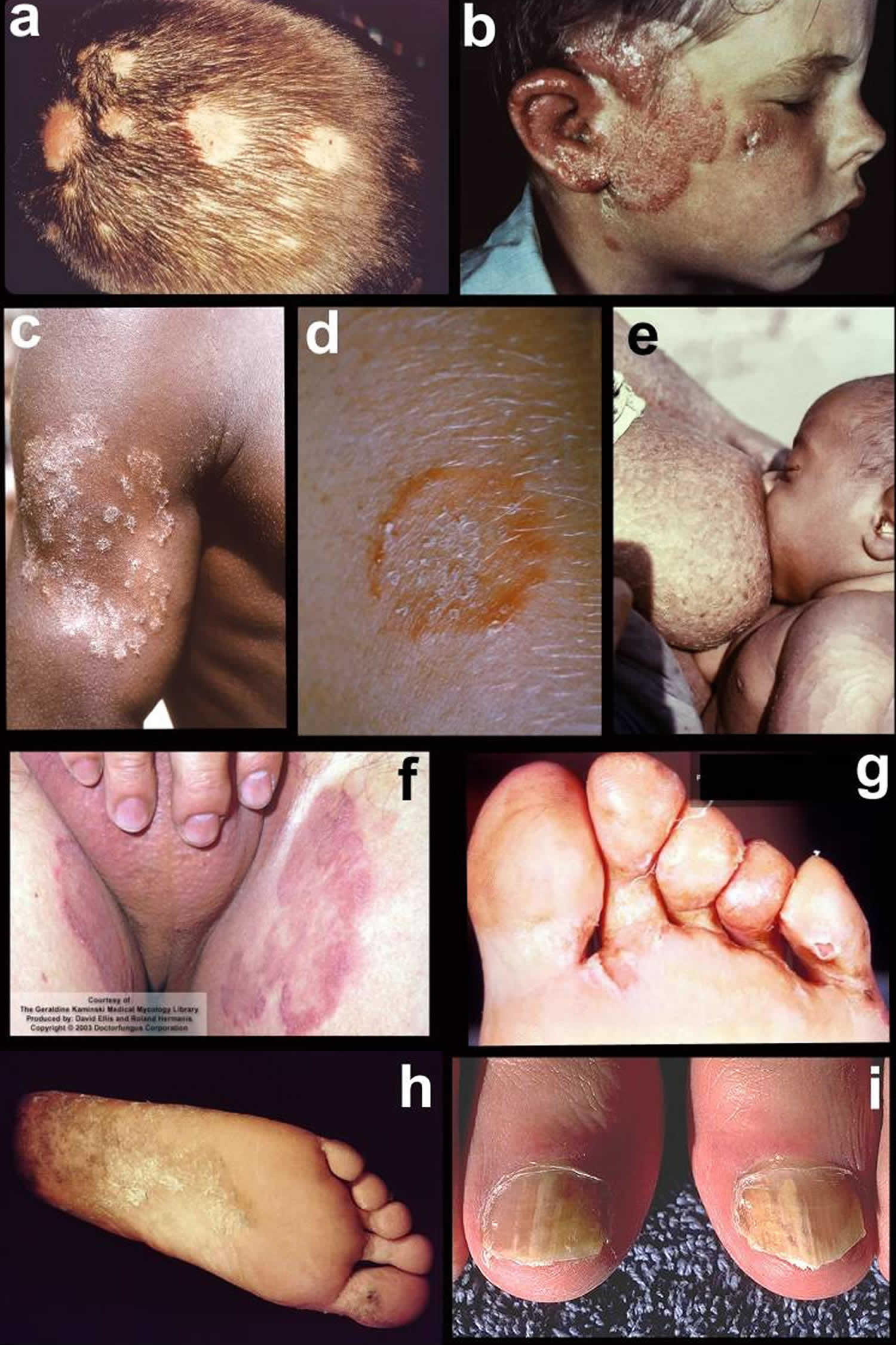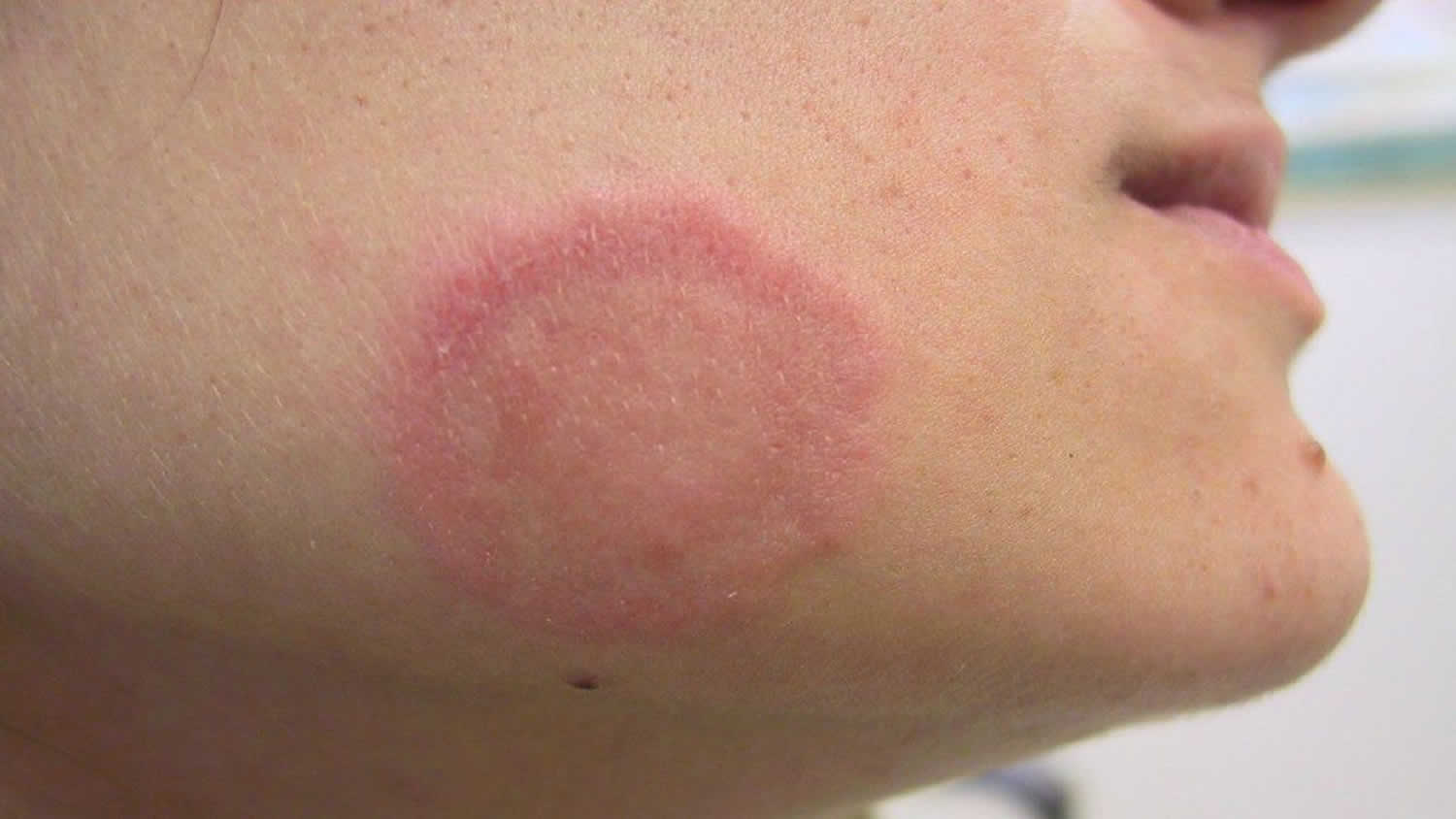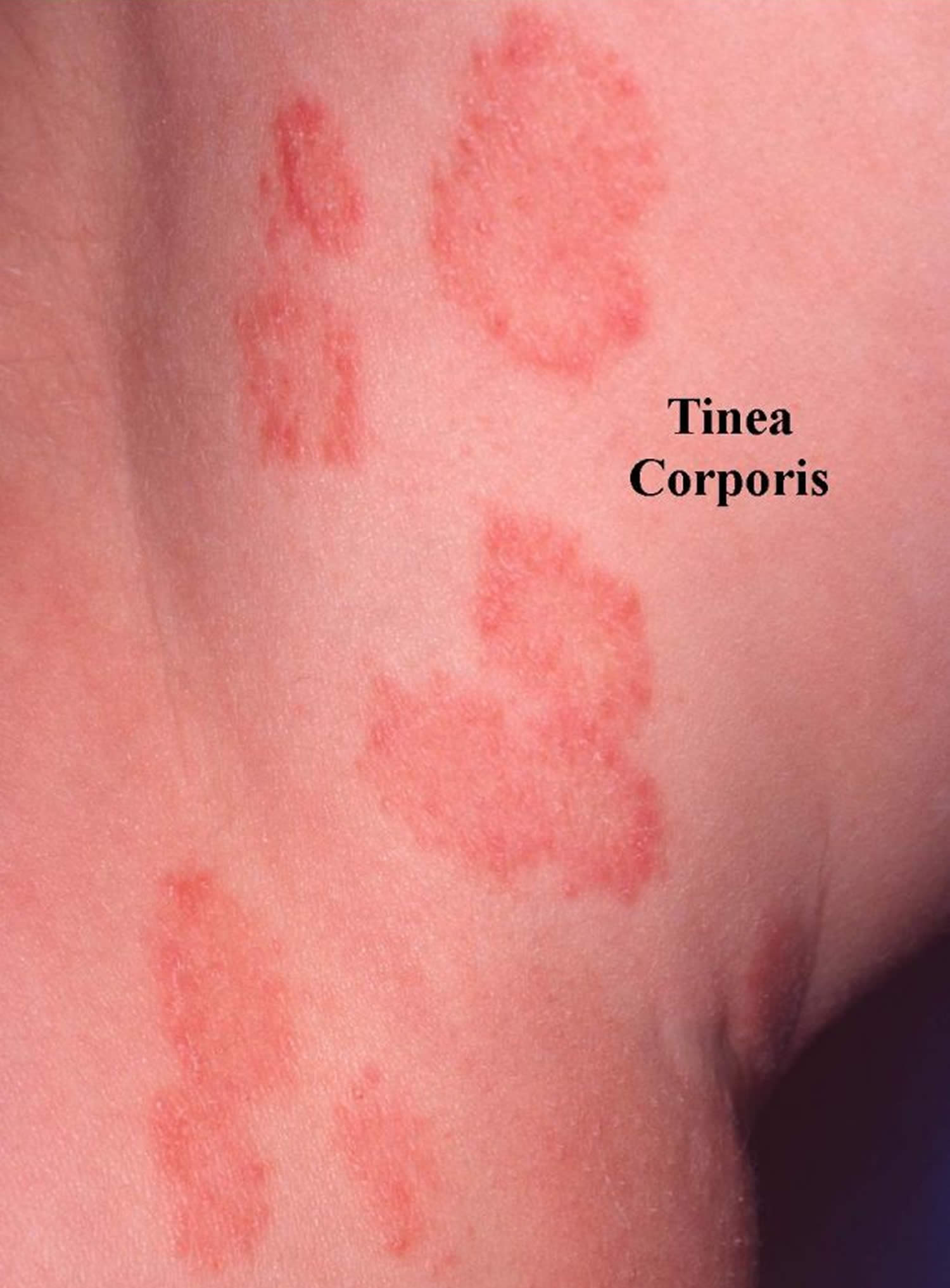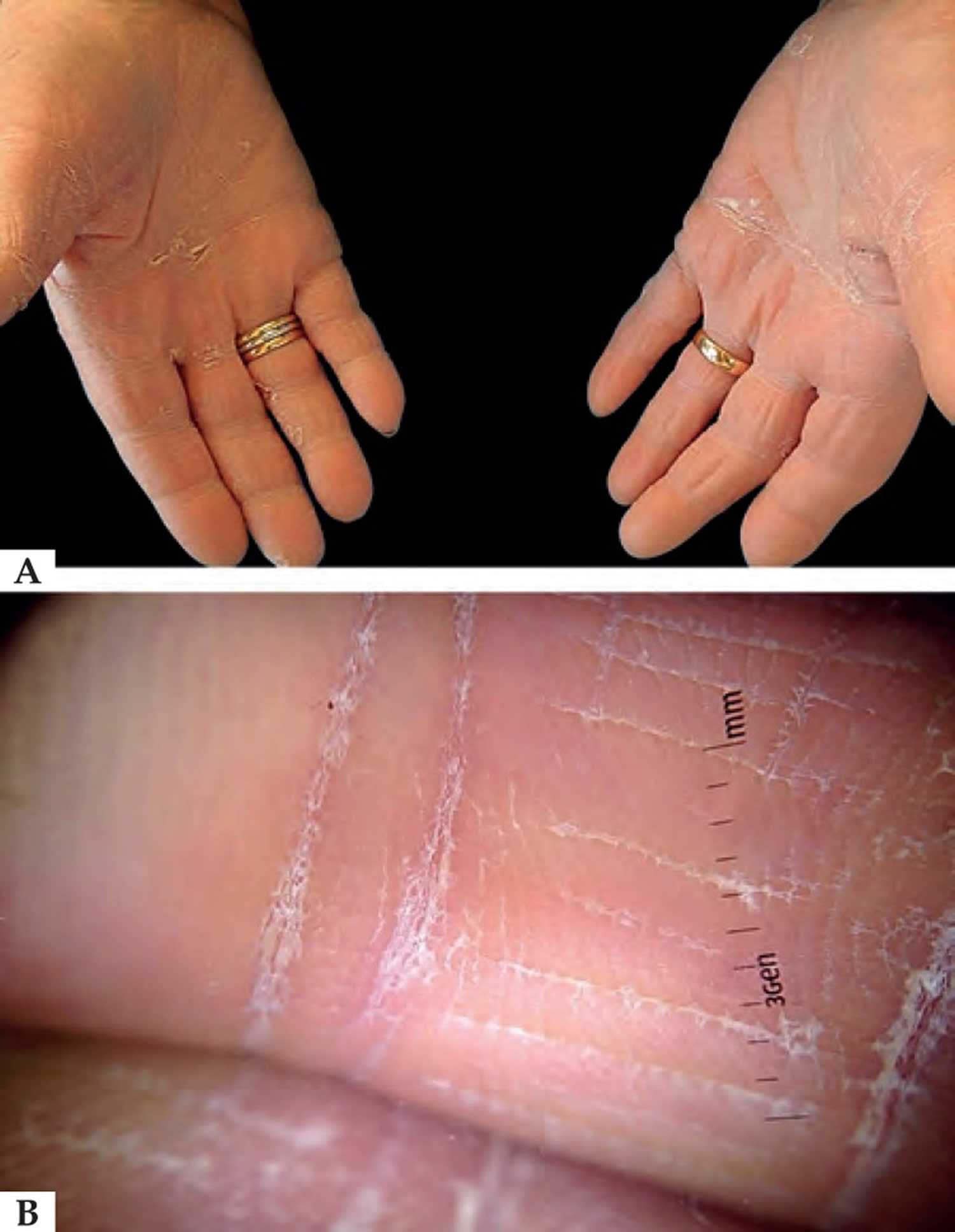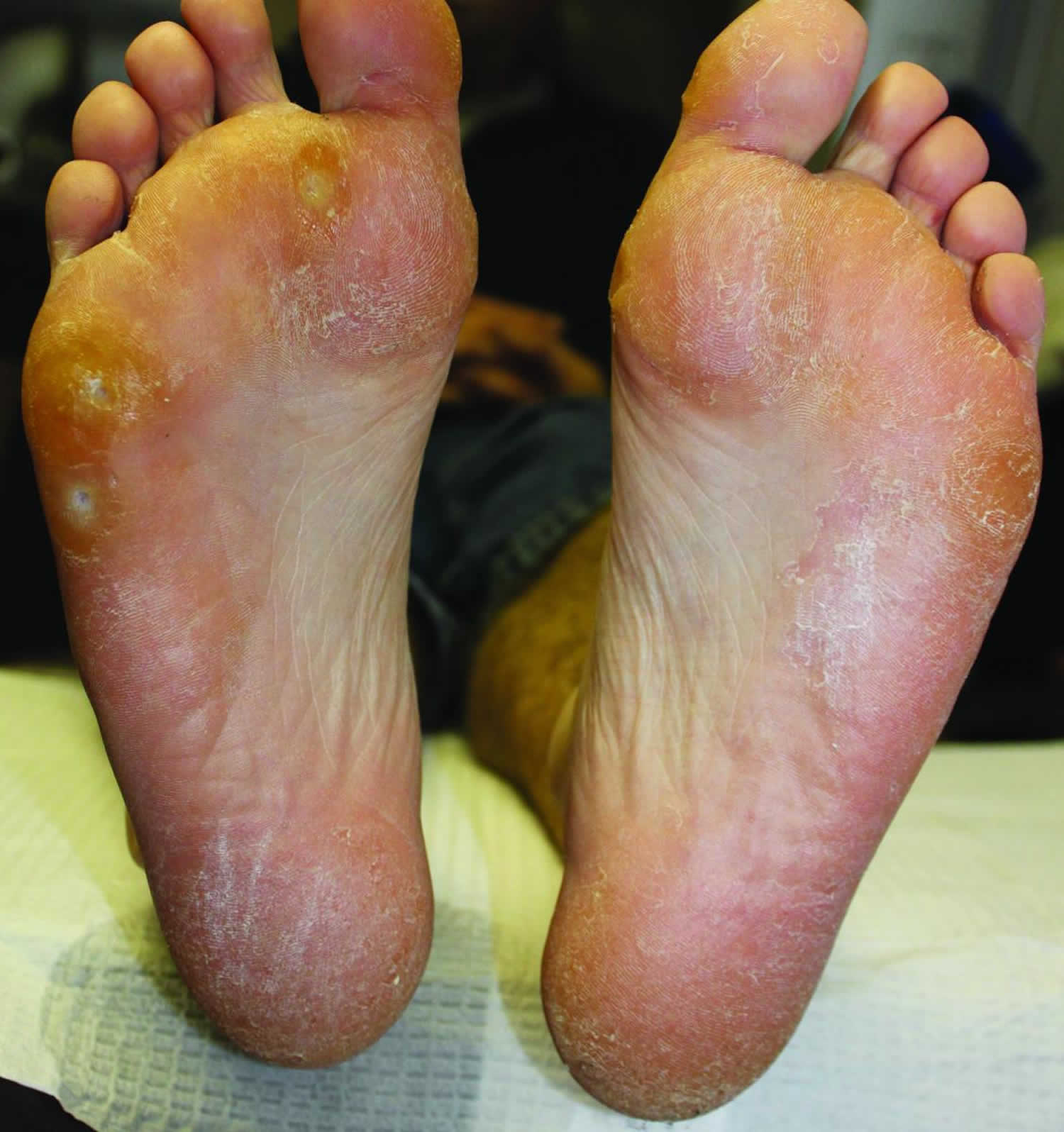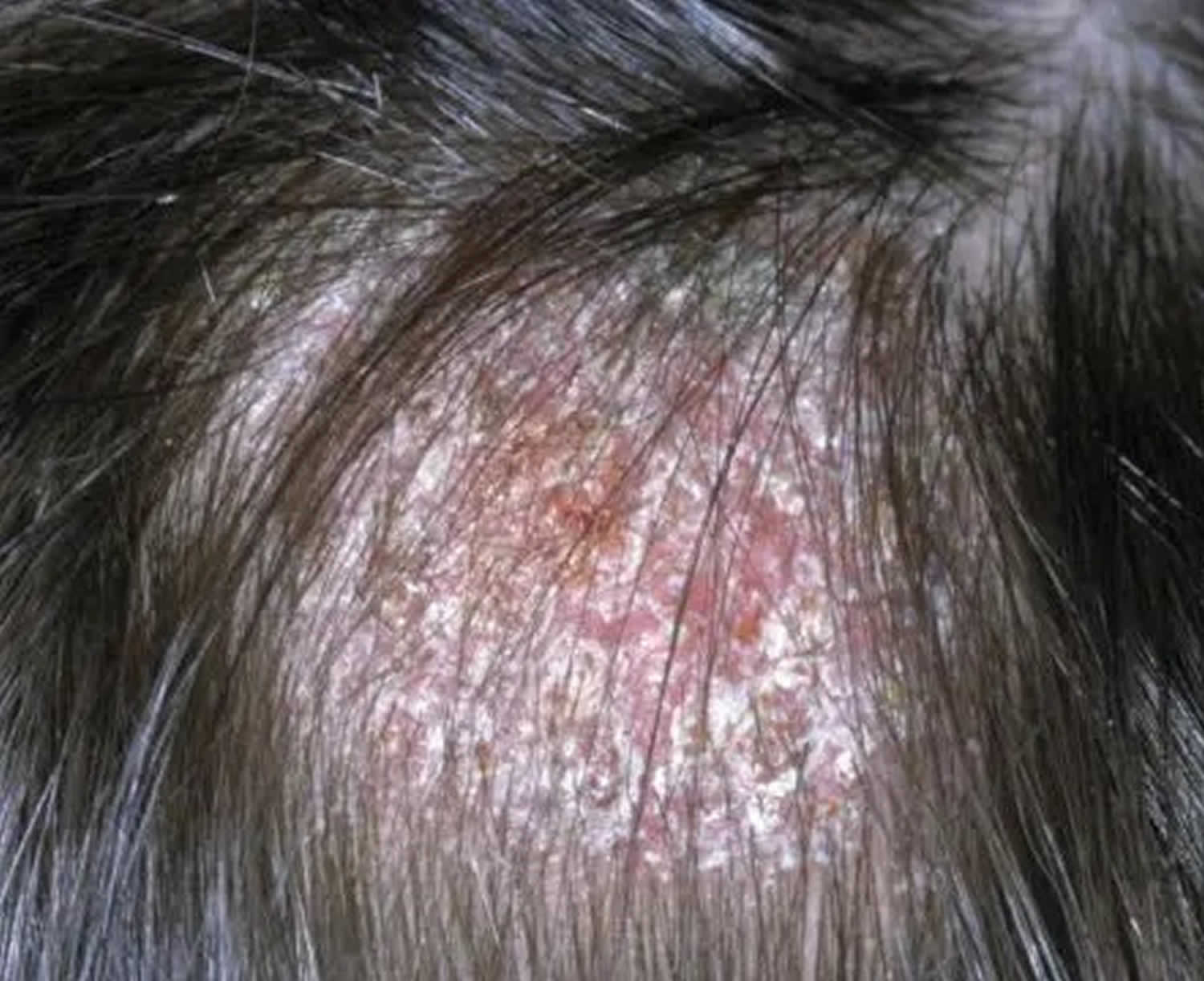Ringworm
Ringworm also known as “tinea” or “dermatophytosis”, is a common fungal skin infection that is caused by a fungus. It’s called “ringworm” because it can cause a circular rash (shaped like a ring) that is usually red, scaly and itchy. There are approximately 40 different species of fungi can cause ringworm; the scientific names for the types of fungi that cause ringworm are Trichophyton, Microsporum, and Epidermophyton 1. No worm is involved. Anyone can get ringworm. The fungi that cause this infection can live on skin, surfaces, and on household items such as clothing, towels, and bedding.
Ringworm rash is itchy and is highly contagious being easily spread by touching an infected person or animal. Ringworm can also be spread by touching objects or surfaces that had contact with the infection. If infected, people often begin itching four to fourteen days after contact. The rash may be scaly, reddened, and circular. Ringworm on the scalp usually makes a bald patch of scaly skin.
Ringworm can affect skin on almost any part of your body as well as fingernails and toenails. Ringworm goes by different names depending on which body part it affects. Ringworm on your body is called tinea corporis. This type of ringworm affects your arms, legs, torso and face.
Areas of the body that can be affected by ringworm include:
- Feet (tinea pedis, commonly called “athlete’s foot”)
- Groin, inner thighs, or buttocks (tinea cruris, commonly called “jock itch”)
- Scalp (tinea capitis)
- Face (tinea faciei)
- Beard (tinea barbae)
- Hands (tinea manuum)
- Toenails or fingernails (tinea unguium, also called “onychomycosis”)
- Other parts of the body such as arms or legs (tinea corporis)
Sometimes, the name gives a different meaning:
- Tinea versicolor is more accurately called pityriasis versicolor. This is a common yeast infection on the trunk.
- Tinea incognito refers to a tinea infection in which the clinical appearance has changed because of inappropriate treatment, usually a topical steroid cream. It is also known as steroid-modified tinea 2.
- Tinea nigra is a mold infection (not a dermatophyte). It affects the palms or soles, which appear brown (on white skin) or black (on dark skin).
The symptoms of ringworm often depend on which part of the body is infected, but they generally include:
- Itchy skin
- Ring-shaped rash
- Red, scaly, cracked skin
- Hair loss
Symptoms typically appear between 4 and 14 days after the skin comes in contact with the fungi that cause ringworm.
Symptoms of ringworm by location on the body:
- Ringworm on the feet (tinea pedis or “athlete’s foot”): The symptoms of ringworm on the feet include red, swollen, peeling, itchy skin between the toes (especially between the pinky toe and the one next to it). The sole and heel of the foot may also be affected. In severe cases, the skin on the feet can blister.
- Ringworm on the scalp (tinea capitis): Ringworm on the scalp usually looks like a scaly, itchy, red, circular bald spot. The bald spot can grow in size and multiple spots might develop if the infection spreads. Ringworm on the scalp is more common in children than it is in adults.
- Ringworm on the groin (tinea cruris or “jock itch”): Ringworm on the groin looks like scaly, itchy, red spots, usually on the inner sides of the skin folds of the thigh.
- Ringworm on the beard (tinea barbae): Symptoms of ringworm on the beard include scaly, itchy, red spots on the cheeks, chin, and upper neck. The spots might become crusted over or filled with pus, and the affected hair might fall out.
- Fungal nail infections also known as “onychomycosis”. Fungal nail infections may cause nails to become discolored, thick, fragile, or cracked. The nail may also become separated from the nail bed. Fungal toenail infections are more common than fungal fingernail infections 3.
Your doctor might suspect you have ringworm by looking at your affected skin and asking questions about your symptoms. Your doctor will generally take a small skin scraping or nail sample to examine under a microscope or send to a laboratory for further testing.
Ringworm is treated with antifungal medication available either over the counter or as a prescription. Mild ringworm often responds to antifungal medications applied to the skin. For more-severe infections, you may need to take prescription-strength oral antifungal medication for several weeks.
Most ringworm infections improve with antifungal treatment, but treatment failure may occur. Common reasons for treatment failure may include incorrect diagnosis and inadequate treatment.
Figure 1. Ringworm rash
[Source 4 ]Figure 2. Ringworm (tineas) throughout the body
Footnote: From top to bottom, left to right: fungal infections of (A) ringworm on the scalp (tinea capitis); (B) ringworm on the face (tinea faciei); (C) ringworm on the arm (tinea corporis); (D) close-up of ringworm; (E) ringworm on the torso with concentric rings (tinea corporis); (F) ringworm on the groin (tinea cruris); (G) ringworm on between the toe webbing (tinea pedis); (H) ringworm on the foot (tinea pedis / “moccasin” type); and (I) ringworm in the nails (onycomycosis).
[Source 5 ]Figure 3. Ringworm on face
Figure 4. Ringworm on neck
Figure 5. Ringworm on body (tinea corporis)
Figure 6. Ringworm on hands
Footnote: (A) Tinea manuum clinical examination shows diffuse white scaling involving the palmar surface and the volar aspect of the fingers of both hands. (B) Polarized light dermoscopy reveals white scaling mainly located in the creases. Direct microscopic examination of 10% potassium hydroxide (KOH) preparation of the scales scraped from the palmar surface showed septate branching hyphae. Cultures of specimens on conventional Sabouraud’s dextrose agar medium showed Trichophyton rubrum growth after three weeks, thus confirming the diagnosis of tinea manuum.
[Source 6 ]Figure 7. Ringworm on leg
Figure 8. Ringworm on foot
Is ringworm contagious?
Yes. Ringworm is a highly contagious fungal skin infection that is spread easily and through close contact with an infected person, animal or object.
Many different kinds of animals can transmit ringworm to people. Dogs and cats, especially kittens or puppies, can have ringworm that can be passed to people. Cows, goats, pigs, and horses can also pass ringworm to people.
Animals, like people, get infected through touching an infected animal’s skin or hair or by touching things that are infected with the fungus, like blankets and towels.
Adult animals, especially long-haired cats, do not always show signs of ringworm infection. Puppies and kittens most often have patches that are hairless, circular, or irregularly shaped areas of scaling, crusting, and redness that may or may not be itchy. The area may not be completely hairless, and instead have brittle, broken hairs. If the claws are affected, they may have a whitish, opaque appearance with shredding of the claw’s surface. If you suspect your pet has ringworm, make sure it is seen by a veterinarian.
Ringworm is also fairly common in show lambs, and is referred to as “club lamb fungus” 7. Lambs usually have circular, hairless areas with thick scabs on their head and face.
How does ringworm spread?
The fungi (Trichophyton, Microsporum, and Epidermophyton) that cause ringworm can live on your skin and in the environment. There are three main ways that ringworm can spread:
- From a person who has ringworm. People can get ringworm after contact with someone who has the infection. To avoid spreading the infection, people with ringworm shouldn’t share clothing, towels, combs, or other personal items with other people.
- From an animal that has ringworm. People can get ringworm after touching an animal that has ringworm. Many different kinds of animals can spread ringworm to people, including dogs and cats, especially kittens and puppies. Other animals, like cows, goats, pigs, and horses can also spread ringworm to people.
- From the environment. The fungi that cause ringworm can live on surfaces, particularly in damp areas like locker rooms and public showers. For that reason, it’s a good idea not to walk barefoot in these places.
Who gets ringworm?
Ringworm is very common. Anyone can get ringworm, but people who have weakened immune systems may be especially at risk for infection and may have problems fighting off a ringworm infection 8. People who use public showers or locker rooms, athletes (particularly those who are involved in contact sports such as wrestling), people who wear tight shoes and have excessive sweating, and people who have close contact with animals may also be more likely to come in contact with the fungi that cause ringworm 9, 10, 11.
My cats and dogs have ringworm and I’m worried about ringworm in my house. What should I do?
Ringworm can easily transfer from animals to humans 12. You can take the following steps to protect yourself and your pet:
For people
- DO
- Wash your hands with soap and running water after playing with or petting your pet.
- Wear gloves and long sleeves if you must handle animals with ringworm, and always wash your hands after handling the animal.
- Vacuum the areas of the home that the infected pet commonly visits. This will help to remove infected fur or flakes of skin.
- Disinfect areas the pet has spent time in, including surfaces and bedding.
- The spores of this fungus can be killed with common disinfectants like diluted chlorine bleach (mix 2 ml of 2.2% household bleach for every 1 liter of water to make a 0.005% solution. Brands vary strength, so check the label. If the concentration is higher, use less bleach, and if the concentration is lower, use more bleach), benzalkonium chloride, or strong detergents.
- Never mix cleaning products. This may cause harmful gases.
- DON’T handle animals with ringworm if your immune system is weak in any way (if you have HIV and AIDS, are undergoing cancer treatment, or are taking medications that suppress your immune system, for example).
For pets
- If you suspect that your pet has ringworm, make sure it is seen by a veterinarian so treatment can be started.
- If one of your pets has ringworm, make sure you have every pet in the household checked by a veterinarian for ringworm infection.
- Your veterinarian may test some fur for the fungus. Treating animals for ringworm can help them clear the infection sooner and prevent spreading the infection to other people and animals.
- Your veterinarian may prescribe antifungal shampoos or creams, dips, or antifungal pills. During this time, the pet should be handled as little as possible until the infection is cleared.
Ringworm causes
Ringworm also called “tinea” or “dermatophytosis,” is a common infection of the epidermis (skin, hair, or nails) caused by dermatophyte fungi (the fungal organisms that cause tinea) 13. There are approximately 40 different species of fungi can cause ringworm; the scientific names for the types of fungi that cause ringworm are Trichophyton (abbreviated as “T”), Microsporum (“M”), and Epidermophyton (“E”) 1. Dermatophytes (the fungal organisms that cause tinea) have the ability to invade keratinized tissue (skin, hair and nails). Infection is normally restricted to the outermost layer of the skin (epidermis).
People can acquire ringworm through direct skin contact with people and animals who are infected. People can also acquire ringworm by sharing personal items (e.g., towels, clothing, bedding) or through contact with surfaces found in moist areas (e.g., shower stalls, locker room floors, pool areas). Ringworm can also spread from one part of the body to another.
Dermatophytes are grouped into three general categories based on their natural environment: anthropophilic (live exclusively on humans), zoophilic (live on an animal host), and geophilic (live in the soil) 14. The majority of human infections are caused by anthropophilic dermatophytes; however, dermatophytes from all three groups have been associated with human disease. For example, pets with ringworm can transmit the infection to their owners, and stray cats carrying dermatophytes are considered to be a vector for infection in several eastern and southern European countries 15.
Anthropophilic dermatophytes are so well adapted to living on human skin that they provoke a minimal inflammatory reaction. Zoophilic or geophilic dermatophytes will often provoke a more vigorous inflammatory reaction when they attempt to invade human skin.
Anthropophilic dermatophytes (live exclusively on humans) include:
- Trichophyton rubrum
- Trichophyton interdigitale
- Trichophyton tonsurans (very common in the USA)
- Microsporum audouinii
- Trichophyton violaceum
- Microsporum ferrugineum
- Trichophyton schoenleinii
- Trichophyton megninii
- Trichophyton soudanense
- Trichophyton yaoundei
Zoophilic dermatophytes (live on an animal host) include:
- Microsporum canis (originating from cats and dogs)
- Trichophyton equinum (originating from horses)
- Trichophyton erinacei (originating from hedgehogs and other animals)
- Trichophyton verrucosum (originating from cattle)
- Microsporum nanum (originating from pigs)
- Microsporum distortum (a variant of M. canis).
Geophilic dermatophytes (live in the soil) include:
- Nannizzia gypsea
- Microsporum fulvum.
Although dermatophytes are found throughout the world, the most prevalent strains and the most common sites of infection vary by region 15, 1. Hot, humid climates and overcrowding predispose populations to skin diseases, including tinea infections 16. Developing countries have high rates of tinea capitis, while developed countries have high rates of tinea pedis and onychomycosis 15.
Low socioeconomic conditions are strongly linked to higher prevalence rates for skin infections, including tinea infections. A review of 18 studies representing large geographical areas determined that tinea capitis is present in up to 19.7% of the general population in developing countries 16. A recent study found tinea capitis present in more than 30% of children at certain grade levels in some urban areas of the United States 17.
High prevalence rates of tinea pedis and onychomycosis have been linked to increased urbanization, community showers, sports, and the use of occlusive footwear 15, 1, 18. These factors are thought to contribute to the high prevalence of tinea pedis in certain occupational groups, including marathon runners (22%–31% prevalence), miners (21%–72.9% prevalence), and soldiers (16.4%–58% prevalence) 15. Several of these studies also found high rates of onychomycosis presenting with tinea pedis. Although tropical and subtropical climates have a higher overall prevalence of skin mycoses, tinea pedis and onychomycosis are rare in India and rural Africa 18.
Ringworm prevention
- Keep your skin clean and dry.
- Wear shoes that allow air to circulate freely around your feet.
- Don’t walk barefoot in areas like locker rooms or public showers.
- Clip your fingernails and toenails short and keep them clean.
- Change your socks and underwear at least once a day.
- Don’t share clothing, towels, sheets, or other personal items with someone who has ringworm.
- Wash your hands with soap and running water after playing with pets. If you suspect that your pet has ringworm, take it to see a veterinarian. If your pet has ringworm, follow the steps below to prevent spreading the infection.
- If you’re an athlete involved in close contact sports, shower immediately after your practice session or match, and keep all of your sports gear and uniform clean. Don’t share sports gear (helmet, etc.) with other players.
Ringworm signs and symptoms
Ringworm typically begins as a flat, discolored patch, which may appear red in lighter complexions and brown in darker complexions. The patch has a ring-like or circular shape with a raised, scaly border.
Ringworm has different names based on where it appears on your body and it can appear just about anywhere.
Symptoms of ringworm by location on the body:
- Ringworm on the feet (tinea pedis or “athlete’s foot”): The symptoms of ringworm on the feet include red, swollen, peeling, itchy skin between the toes (especially between the pinky toe and the one next to it). The sole and heel of the foot may also be affected. In severe cases, the skin on the feet can blister.
- Ringworm on the scalp (tinea capitis): Ringworm on the scalp usually looks like a scaly, itchy, red, circular bald spot. The bald spot can grow in size and multiple spots might develop if the infection spreads. Ringworm on the scalp is more common in children than it is in adults.
- Ringworm on the face (tinea faciei): Ringworm on the face does not include infection of the beard and moustache area, which is called tinea barbae. Tinea faciei resembles tinea corporis (ringworm). It may be acute (sudden onset and rapid spread) or chronic (slow extension of a mild, barely inflamed, rash). There are round or oval red scaly patches, often less red and scaly in the middle or healed in the middle. It is frequently aggravated by sun exposure. It may also present as a kerion (fungal abscess). Tinea faciei is uncommon and often misdiagnosed at first.
- Ringworm on the body (tinea corporis): Ringworm on the body (tinea corporis) is a superficial fungal infection of the skin that can affect any part of the body, excluding the hands and feet, scalp, face and beard, groin, and nails. Ringworm on the body (tinea corporis) is most commonly seen in children and young adults, however all age groups can be infected including newborns. Ringworm on the body (tinea corporis) initially presents as a solitary circular red patch with a raised scaly leading edge. A lesion spreads out from the centre forming a ring-shape with central hypopigmentation and a peripheral scaly red rim (ringworm). The border can be papular or pustular. Itch is common. With time, multiple lesions can develop which may coalesce to form a polycyclic pattern. The distribution of lesions is typically asymmetrical.
- Ringworm on the groin (tinea cruris or “jock itch”): Ringworm on the groin looks like scaly, itchy, red spots, usually on the inner sides of the skin folds of the thigh.
- Ringworm on the beard (tinea barbae): Symptoms of ringworm on the beard include scaly, itchy, red spots on the cheeks, chin, and upper neck. The spots might become crusted over or filled with pus, and the affected hair might fall out.
- Fungal nail infections also known as “onychomycosis”. Fungal nail infections may cause nails to become discolored, thick, fragile, or cracked. The nail may also become separated from the nail bed. Fungal toenail infections are more common than fungal fingernail infections 3.
Ringworm diagnosis
Ringworm may be difficult to distinguish from other skin conditions 19. Physical examination with the help of dermatoscopy and clinical history alone may not be enough to diagnose ringworm. Doctors often use a diagnostic test to confirm suspected ringworm, especially before prescribing antifungal treatment. Clinicians should generally confirm the diagnosis of scalp fungus (tinea capitis) using a laboratory test 13.
The presence of a dermatophyte infection is confirmed by:
- Microscopy and culture of skin scrapings
- Histopathological examination of skin or nail biopsy using periodic acid-Schiff (PAS) stains to reveal fungal elements
- Specific antigen tests using molecular biology techniques such as polymerase chain reaction (PCR).
Potassium hydroxide preparation
Doctors often use a potassium hydroxide (KOH) preparation of skin scrapings or nail clippings to confirm a diagnosis of ringworm. This test can provide rapid results, but the test’s accuracy depends on clinician experience and technique 20.
Fungal culture
Fungal culture can be used to diagnose ringworm. Fungal culture is more specific than potassium hydroxide (KOH) stain, but results may take several weeks 21, 22.
Note: Antifungal-resistant fungal nail infections (onychomycosis) is a growing problem 23, 24, 25 Therefore, antifungal susceptibility testing may be considered based on the fungus or fungi identified and the patient’s clinical course.12,16,17
Histopathologic examination with a periodic acid-Schiff stain
Histopathologic examination of nail clippings with a periodic acid-Schiff (PAS) stain is a method for confirming the diagnosis for patients with suspected onychomycosis, a fungal nail infection most often caused by dermatophytes.
Polymerase chain reaction (PCR)
Ultraviolet light (Wood’s lamp)
Ultraviolet light can be useful for diagnosing ringworm caused by Microsporum canis and Microsporum audouinii. Although both species fluoresce blue-green under a Wood’s lamp, these species are uncommon causes of ringworm infections in people.
Ringworm treatment
best medicine for ringworm
Ringworm on foot treatment
Tinea pedis or athlete’s foot can usually be treated with over-the-counter topical antifungal products. Chronic or extensive tinea pedis may require treatment with oral antifungal medications such as terbinafine, itraconazole, or fluconazole 26. In addition, chronic tinea pedis may require adjunctive therapy such as foot powder or talcum powder to prevent skin maceration.
Scalp fungus treatment
Scalp fungus or tinea capitis requires prescription-strength oral antifungal medication, as topical antifungal products are ineffective for treatment of tinea capitis 27. Many experts consider griseofulvin to be the drug of choice 26. Terbinafine is also FDA-approved for the treatment of tinea capitis in patients four years of age and older. Itraconazole (Spoanox, Tolsura) and fluconazole (Diflucan) have been shown to be safe and effective, but are not FDA-approved for this indication 26. You or your child might need to take one of these medications for six weeks or more until the hair regrows. Typically, with successful treatment, the bald spots will grow hair again and the skin will heal without scarring.
Your doctor might recommend that you or your child also wash you or your child’s hair with a prescription-strength medicated shampoo such as selenium sulfide shampoos 26, 28. The shampoo removes fungus spores and helps prevent spreading the infection to others or to other areas of your body.
There is no need to shave the head or cut the hair as part of the treatment.
Tinea corporis and tinea cruris treatment
Tinea corporis and tinea cruris can usually be treated with topical antifungal products 26. Patients who have tinea cruris should be advised to keep the groin area clean and dry and to wear cotton underwear. Patients who have extensive or recurrent infections may require prescription-strength oral antifungal medication 26.
Fungal nail treatment
Fungal nail infections can be difficult to cure, and treatment is most successful when started early. Fungal nail infections typically don’t go away on their own, and the best treatment is usually prescription antifungal pills taken by mouth. Oral antifungal therapy should be prescribed only after confirmation of fungal infection. Oral terbinafine is typically the first-line treatment for confirmed fungal nail infections (onychomycosis). The treatment course is generally 6 weeks for fingernails and 12 weeks for toenails 29. Given increasing reports of terbinafine resistance in fungal nail infections (onychomycosis), the possibility of resistance should be considered if patients do not improve with therapy. Identification and susceptibility testing of the causative fungus or fungi may help guide therapy. Note, however, that antimicrobial resistance is not the only possible reason for treatment failure 30. Clinicians should also consider the possibility of incorrect diagnosis or inadequate patient adherence to therapy.
Laser treatments for onychomycosis appear to be a promising area for future study 31.
In severe cases, your doctor might remove the affected nail completely. It can take several months to a year for the infection to go away.
Fungal nail infections can be closely associated with fungal skin infections. If a fungal infection is not treated, it can spread from one place to the other. You should discuss all skin concerns with their doctor to ensure that all fungal infections are properly treated.
Even after treatment, fungal nail infections can come back 32. This is more common in people who have conditions like diabetes that make them more likely to get a fungal nail infection. If you suspect an infection has returned, contact your healthcare provider.
Scalp ringworm
Ringworm of the scalp is also called tinea capitis, is a highly contagious rash caused by a fungal infection. Ringworm of the scalp is most common in toddlers and school-age children. Ringworm of the scalp (tinea capitis) usually causes itchy, scaly, bald patches on the head. However, several conditions affecting the scalp may have a similar appearance to ringworm of the scalp (tinea capitis). So it’s important that you or your child see a doctor if you or your child has any hair loss, scaling or itchiness of the scalp, or other unusual appearance of the scalp. It’s important to get an accurate diagnosis and prompt treatment with prescription medicine. Nonprescription creams, lotions and powders won’t get rid of ringworm of the scalp.
Medication taken by mouth can kill the fungus that causes ringworm of the scalp. Medicated shampoos may help keep a person from spreading the infection to others.
Figure 9. Ringworm of the scalp
Footnote: Ringworm of the scalp appears as round patches where the hair has broken off at or just above the scalp. These bald-looking patches slowly grow larger.
Figure 10. Close up view of the scalp with ringworm
Footnote: Close up view of the scalp with ringworm that can look scaly and silvery with patches of broken hair. You may also see small black dots if the hair has broken off right at the scalp.
Figure 11. Kerion
Footnote: Kerion appears as soft, raised swellings that drain pus and cause thick, yellow crusting on the scalp. With kerion, the hair falls out or can be easily pulled out. Kerion may be caused by an overly vigorous reaction to the fungus and can lead to scarring and permanent hair loss.
Ringworm on scalp causes
Ringworm of the scalp is caused by a common fungus. The fungus attacks the outer layer of skin on the scalp and the hair. This causes those hairs to break. The condition can be spread in the following ways:
- Human to human. Ringworm often spreads through direct skin-to-skin contact with an infected person.
- Animal to human. You can contract ringworm by touching an animal with ringworm. Ringworm can spread while petting or grooming dogs or cats with ringworm. Ringworm is fairly common in kittens, puppies, cows, goats, pigs and horses.
- Object to human. It’s possible for ringworm to spread by contact with objects or surfaces that an infected person or animal has recently touched. This includes items such as clothing, towels, bedding, combs and brushes.
Risk factors for ringworm of the scalp
Risk factors for ringworm of the scalp include:
- Age. Ringworm of the scalp is most common in toddlers and school-age children.
- Exposure to other children. Outbreaks of ringworm are common in schools and child care centers where the infection easily spreads with close contact.
- Exposure to pets. A pet, such as a cat or a dog, can have the infection without showing any signs. Children can get the infection by touching the animal.
Ringworm on scalp prevention
Ringworm of the scalp is difficult to prevent. The fungus that causes it is common, and the condition is contagious even before symptoms appear. Take these steps to reduce the risk of ringworm:
- Educate yourself and others. Be aware of the risk of ringworm from infected people or pets. Tell children about ringworm, what to watch for and how to avoid the infection.
- Shampoo regularly. Be sure to wash your child’s scalp regularly, especially after haircuts. Some scalp conditioning products, such as coconut oil and pomades with selenium, might help prevent ringworm of the scalp.
- Keep skin clean and dry. Be sure children wash their hands, including after playing with pets. Keep shared areas clean, especially in schools, child care centers, gyms and locker rooms.
- Avoid infected animals. The infection often looks like a patch of skin where fur is missing. If you have pets or other animals that commonly carry ringworm, ask your veterinarian to check them for the infection.
- Avoid sharing personal items. Teach children not to let others use their clothing, towels, hairbrushes, sports gear or other personal items.
Ringworm on scalp signs and symptoms
Signs and symptoms of ringworm of the scalp may include:
- One or more round, scaly or inflamed patches where the hair has broken off at or near the scalp
- Patches that slowly get bigger and have small, black dots where the hair has broken off
- Brittle or fragile hair that can be easily broken or pulled out
- Tender or painful areas on the scalp due to severe inflammation called kerion. Kerion appears as soft, raised swellings that drain pus and cause thick, yellow crusting on the scalp. With kerion, the hair falls out or can be easily pulled out. Kerion may be caused by an overly vigorous reaction to the fungus and can lead to scarring and permanent hair loss.
Ringworm on scalp diagnosis
Your doctor will likely be able to diagnose ringworm of the scalp by looking at the affected skin and asking certain questions. To confirm the diagnosis, your doctor may take a sample of hair or skin to be tested in a lab. Testing a sample of hair or skin can show if a fungus is present.
Ringworm on scalp treatment
Treatment for ringworm of the scalp requires a prescription-strength oral antifungal medication to be taken by mouth. The first-choice medication is usually griseofulvin (Gris-Peg). Alternatives might be used if griseofulvin isn’t working or your child is allergic to it. These include terbinafine, itraconazole (Spoanox, Tolsura) and fluconazole (Diflucan). You or your child might need to take one of these medications for six weeks or more until the hair regrows. Typically, with successful treatment, the bald spots will grow hair again and the skin will heal without scarring.
Your doctor might recommend that you or your child also wash you or your child’s hair with a prescription-strength medicated shampoo such as selenium sulfide shampoos 26, 28. The shampoo removes fungus spores and helps prevent spreading the infection to others or to other areas of your body.
There is no need to shave the head or cut the hair as part of the treatment.
References- Havlickova, B., Czaika, V.A. and Friedrich, M. (2008), Epidemiological trends in skin mycoses worldwide. Mycoses, 51: 2-15. https://doi.org/10.1111/j.1439-0507.2008.01606.x
- Verma S. Steroid modified tinea. BMJ. 2017 Mar 8;356:j973. doi: 10.1136/bmj.j973
- Gupta AK, Jain HC, Lynde CW, Macdonald P, Cooper EA, Summerbell RC. Prevalence and epidemiology of onychomycosis in patients visiting physicians’ offices: a multicenter canadian survey of 15,000 patients. J Am Acad Dermatol. 2000 Aug;43(2 Pt 1):244-8. doi: 10.1067/mjd.2000.104794
- Leung AK, Lam JM, Leong KF, Hon KL. Tinea corporis: an updated review. Drugs Context. 2020 Jul 20;9:2020-5-6. doi: 10.7573/dic.2020-5-6
- Achterman RR, White TC. A foot in the door for dermatophyte research. PLoS Pathog. 2012;8(3):e1002564. doi: 10.1371/journal.ppat.1002564
- Errichetti E, Stinco G. Dermoscopy in tinea manuum. An Bras Dermatol. 2018 Jun;93(3):447-448. doi: 10.1590/abd1806-4841.20186366
- Ringworm. Healthy Pets, Healthy People. https://www.cdc.gov/healthypets/diseases/ringworm.html
- Crissey JT, Lang H, Parish LC. Manual of Medical Mycology, Blackwell Science, Cambridge 1995. p.36.
- Wilson EK, Deweber K, Berry JW, Wilckens JH. Cutaneous infections in wrestlers. Sports Health. 2013 Sep;5(5):423-37. doi: 10.1177/1941738113481179
- Pickup TL, Adams BB. Prevalence of tinea pedis in professional and college soccer players versus non-athletes. Clin J Sport Med. 2007 Jan;17(1):52-4. doi: 10.1097/JSM.0b013e31802ed88e
- Pecci M, Comeau D, Chawla V. Skin conditions in the athlete. Am J Sports Med. 2009 Feb;37(2):406-18. doi: 10.1177/0363546508325663
- Kaplan W. Epidemiology and Public Health Significance of Ringworm in Animals. Arch Dermatol. 1967;96(4):404–408. doi:10.1001/archderm.1967.01610040054010
- Ely JW, Rosenfeld S, Seabury Stone M. Diagnosis and Management of Tinea Infections. Am Fam Physician. 2014;90(10):702-711. https://www.aafp.org/pubs/afp/issues/2014/1115/p702.html
- Weitzman I, Summerbell RC. The dermatophytes. Clin Microbiol Rev. 1995 Apr;8(2):240-59. https://www.ncbi.nlm.nih.gov/pmc/articles/PMC172857/pdf/080240.pdf
- Seebacher C, Bouchara JP, Mignon B. Updates on the epidemiology of dermatophyte infections. Mycopathologia. 2008 Nov-Dec;166(5-6):335-52. doi: 10.1007/s11046-008-9100-9
- World Health Organization. Epidemiology and management of common skin diseases in children in developing countries. Department of Child and Adolescent Health and Development. 2005. 54 WHO reference number WHO/FCH/CAH/05.12.
- Abdel-Rahman SM, Farrand N, Schuenemann E, Stering TK, Preuett B, Magie R, Campbell A. The prevalence of infections with Trichophyton tonsurans in schoolchildren: the CAPITIS study. Pediatrics. 2010 May;125(5):966-73. doi: 10.1542/peds.2009-2522
- Ameen M. Epidemiology of superficial fungal infections. Clin Dermatol. 2010 Mar 4;28(2):197-201. doi: 10.1016/j.clindermatol.2009.12.005
- Yadgar RJ, Bhatia N, Friedman A. Cutaneous fungal infections are commonly misdiagnosed: A survey-based study. J Amer Acad Dermatol. 2017 March; 76(3): 562-563. https://doi.org/10.1016/j.jaad.2016.09.041
- Levitt JO, Levitt BH, Akhavan A, Yanofsky H. The Sensitivity and Specificity of Potassium Hydroxide Smear and Fungal Culture Relative to Clinical Assessment in the Evaluation of Tinea Pedis: A Pooled Analysis. Derma Res and Prac. 2010 Jun; 2010. https://doi.org/10.1155/2010/764843
- Hainer BL. Dermatophyte infections. Am Fam P 2003 Jan 1;67(1):101-8. https://www.aafp.org/pubs/afp/issues/2003/0101/p101.html
- Crawford F, Hollis S. Topical treatments for fungal infections of the skin and nails of the foot. Cochrane Database Syst Rev. 2007 Jul 18;2007(3):CD001434. doi: 10.1002/14651858.CD001434.pub2
- Saunte DML, Hare RK, Jorgensen KM, Jorgensen R, Deleuran M, Zachariae CO, et al. Emerging Terbinafine Resistance in Trichophyton: Clinical Characteristics, Squalene Epoxidase Gene Mutations, and a Reliable EUCAST Method for Detection. Antimic Agent and Chemo. 2019 Sept; 63(10). https://doi.org/10.1128/AAC.01126-19
- Gupta AK, Renaud HJ, Quinlan EM, Shear NH, Piguet V. The Growing Problem of Antifungal Resistance in Onychomycosis and Other Superficial Mycoses. Am J Clin Dermatol. 2021 Mar;22(2):149-157. doi: 10.1007/s40257-020-00580-6
- Astvad KMT, Hare RK, Jørgensen KM, Saunte DML, Thomsen PK, Arendrup MC. Increasing Terbinafine Resistance in Danish Trichophyton Isolates 2019–2020. Journal of Fungi. 2022; 8(2):150. https://doi.org/10.3390/jof8020150
- Michaels BD, Del Rosso JQ. Tinea capitis in infants: recognition, evaluation, and management suggestions. J Clin Aesthet Dermatol. 2012 Feb;5(2):49-59. https://www.ncbi.nlm.nih.gov/pmc/articles/PMC3315884
- Ringworm Information for Healthcare Professionals. https://www.cdc.gov/fungal/diseases/ringworm/health-professionals.html
- Allen HB, Honig PJ, Leyden JJ, McGinley KJ. Selenium sulfide: adjunctive therapy for tinea capitis. Pediatrics. 1982 Jan;69(1):81-3.
- Onychomycosis: current and future therapies. Cutis. 2014 Feb;93(2):60-3.
- Gupta AK, Venkataraman M, Renaud HJ, Summerbell R, Shear NH, Piguet V. A Paradigm Shift in the Treatment and Management of Onychomycosis. Skin Append Disord. 2021;7(5). https://doi.org/10.1159/000516112
- Ghannoum MA, Hajjeh RA, Scher R, Konnikov N, Gupta AK, Summerbell R, Sullivan S, Daniel R, Krusinski P, Fleckman P, Rich P, Odom R, Aly R, Pariser D, Zaiac M, Rebell G, Lesher J, Gerlach B, Ponce-De-Leon GF, Ghannoum A, Warner J, Isham N, Elewski B. A large-scale North American study of fungal isolates from nails: the frequency of onychomycosis, fungal distribution, and antifungal susceptibility patterns. J Am Acad Dermatol. 2000 Oct;43(4):641-8. doi: 10.1067/mjd.2000.107754
- Tosti A, Elewski BE. Onychomycosis: Practical Approaches to Minimize Relapse and Recurrence. Skin Appendage Disord. 2016 Sep;2(1-2):83-87. doi: 10.1159/000448056
